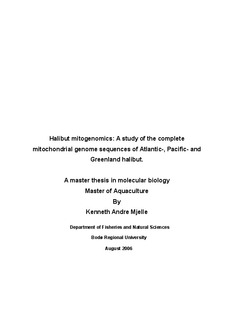Halibut mitogenomics : a study of the complete mitochondrial genome sequences of Atlantic, Pacific and Greenland halibut
Master thesis
Permanent lenke
http://hdl.handle.net/11250/141179Utgivelsesdato
2006Metadata
Vis full innførselSamlinger
Sammendrag
The complete mitochondrial DNA sequence was determined in four individuals of Atlantic
halibut (Hippoglossus hippoglossus), Pacific halibut (Hippoglossus stenolepis) and Greenland
halibut (Reinhardtius hippoglossoides) respectively. Thirteen protein-coding genes, twentytwo
tRNA genes, two rRNA genes and a large non-coding control region were identified, and
the conserved vertebrate gene order was confirmed. Extensive length variation of the mtDNA
genome was observed, due to variations in copy number of a 61 bp heteroplasmic repeated
motif in the control region.
Furthermore, 800 bp from the mtDNA genes ND2, COI and control region respectively was
sequenced in 30 individuals from the Atlantic halibut broodstock at Mørkvedbukta Reseach
Station. In addition, approximately 13420 bp from Common sole (Solea vulgaris), 15012 bp
from European plaice (Pleuronectes platessa) and 7678 bp from Turbot (Scophthalmus
maximus) were determined.
The overall genetic variation based on the number of nucleotide substitutions was greatest in
Greenland halibut, followed by Pacific halibut and Atlantic halibut. The control region and
some of the ND genes had the highest nucleotide diversity, while the rRNA genes and ATP8
(Pacific and Greenland halibut) were most conserved. Four amino acid substitutions between
the three halibut species in ND5, with a negative mutation matrix score suggest that these
substitutions could have an impact on functional and structional properties of the gene.
Phylogenetic investigations based on the complete mtDNA genome revealed that Atlantic
halibut and Pacific halibut are closely related species, potentially separated at the sub-species
level. Of all other available mtDNA genomes Greenland halibut is the closest relative to the
Hippoglossus genus. Furthermore, Atlantic- and Pacific halibut was estimated to have
separated 2 Ma, while divergence between Greenland halibut and the Hippoglossus genus
took place approximately 6 million years ago.
Beskrivelse
Mastergradsoppgave i havbruk - Høgskolen i Bodø, 2006
